How an Anemometer Can Enhance Your Weather Tracking System
How an Anemometer Can Enhance Your Weather Tracking System
Blog Article
Discovering the Functions and Benefits of Anemometers for Weather Condition Fanatics and Experts
Anemometers stand as critical tools in the realm of climate surveillance, accommodating both enthusiasts and experienced professionals alike. These devices supply a home window right into the dynamic globe of wind patterns and speeds, supplying indispensable data for meteorological analysis and projecting. From mug anemometers to sonic anemometers, each kind brings its special set of advantages and applications, dropping light on different elements of climatic conditions. As we look into the features and benefits of anemometers, a deeper understanding emerges not only of prevailing weather sensations yet additionally of the wider effects for industries like wind energy manufacturing and environmental research study.
Value of Anemometers in Weather Tracking
Anemometers play an essential duty in climate surveillance by supplying precise dimensions of wind speed, assisting in forecasting and understanding climate patterns. These tools, ranging from conventional cup anemometers to modern ultrasonic anemometers, are important for meteorologists, researchers, and weather fanatics alike. By determining wind rate, anemometers assist in establishing the intensity of weather sensations such as typhoons, hurricanes, and tornados. Furthermore, they supply important data for air travel, maritime procedures, and numerous industries that are delicate to wind conditions.

Sorts Of Anemometers and Their Applications
The most common types of anemometers consist of mug anemometers, vane anemometers, hot-wire anemometers, and ultrasonic anemometers. Cup anemometers consist of three or four cups installed on horizontal arms that turn with the wind, determining its rate. Vane anemometers, on the other hand, use an openly revolving vane to line up with the wind instructions, providing both wind rate and direction dimensions.
Cup anemometers are ideal and robust for basic weather surveillance, while vane anemometers are preferred for directional measurements. Ultrasonic anemometers are non-intrusive and provide high precision, often utilized in research and specialized climate monitoring applications.
Benefits of Using Anemometers in Projecting
In weather forecasting, the usage of anemometers uses very useful benefits for improving the accuracy of weather condition forecasting. Anemometers gauge wind rate and direction, giving vital information for forecasting climate patterns. By incorporating wind information right into projecting designs, meteorologists can much better understand the movement of weather condition systems, prepare for adjustments in weather, and problem more accurate forecasts.
Moreover, anemometers play an important role in evaluating prospective weather next page condition risks. Keeping track of wind rates assists forecasters predict serious climate occasions such as hurricanes, hurricanes, and winter tornados with better precision. This early caution system allows authorities to provide prompt notifies and carry out needed safety steps, minimizing the dangers to life and home.
Additionally, anemometers assist in optimizing sustainable energy production. By evaluating wind patterns, meteorologists can recognize appropriate locations for wind ranches and forecast power output, contributing to the effective generation of wind power.

Anemometers in Wind Energy Manufacturing
Given the critical duty anemometers play in offering accurate wind information for weather projecting and hazard assessment, their importance extends to the world of wind power production. Anemometers are essential tools in the area of wind power, where the measurement of wind speed and direction is essential for figuring out the usefulness and performance of wind generator setups. By accurately measuring wind rates at differing heights, anemometers assist maximize the placement and layout of wind turbines to take full advantage of energy outcome.
In wind ranches, anemometers are purposefully placed official website to accumulate real-time wind data that is made use of to examine the prospective power manufacturing of a site. This data contributes in determining the financial practicality of wind power tasks and in forecasting power generation to make sure grid stability. Furthermore, anemometers aid in keeping track of wind conditions to maximize turbine efficiency, protect against damages from high winds, and guarantee the safety and security of personnel functioning in the location of wind turbines.
Enhancing Weather Condition Recognizing With Anemometers

Anemometers play a key duty in boosting our understanding of microclimates. These local climate problems can vary considerably from more comprehensive regional projections, helpful resources making it vital to have accurate information for certain locations. anemometer. By strategically putting anemometers in different locations, researchers can gather thorough information on how wind acts in different terrains, city environments, or bodies of water
Moreover, anemometers contribute to boosting climate projecting designs by giving real-time data on wind actions. This info is especially useful for forecasting severe weather condition occasions, enhancing agricultural methods, and sustaining industries like aeronautics and maritime navigating. Overall, anemometers are invaluable tools that enable us to delve deeper into the intricacies of weather condition systems, ultimately resulting in more better-informed decisions and accurate forecasts.
Verdict
In verdict, anemometers play an important duty in climate tracking and projecting by determining wind speed and direction. Anemometers likewise have applications in wind energy manufacturing, more highlighting their importance in both meteorology and renewable power sectors.
From cup anemometers to sonic anemometers, each type brings its distinct collection of benefits and applications, shedding light on various aspects of climatic conditions. These tools, varying from traditional cup anemometers to modern-day ultrasonic anemometers, are important for meteorologists, scientists, and weather fanatics alike. The most common kinds of anemometers include cup anemometers, vane anemometers, hot-wire anemometers, and ultrasonic anemometers. Cup anemometers are durable and suitable for general climate monitoring, while vane anemometers are preferred for directional dimensions. Anemometers are important instruments in the field of wind energy, where the measurement of wind speed and instructions is critical for figuring out the feasibility and efficiency of wind turbine setups.
Report this page